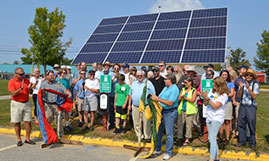What We Do
Our Focus: The COVID-19 pandemic created unprecedented disruptions in our families, communities, and workplaces. Although the brunt of the impacts has lessened, the issues that emerged persist because most exacerbated the longstanding inequities and disparities of affordable housing, food insecurity, and economic hardship.
Recognizing the deep interconnections among these issues over generations, the Maine Alliance for Health and Prosperity is leveraging the pandemic crises to advance positive, “upstream” policy changes that can improve the health and economic well-being of all Maine people and communities.
Our Commitment to Action: Hundreds of recommendations or policies, programs, and investments have been proposed or implemented (thanks to federal and state COVID relief and economic development investments) to improve Maine’s health and economy – many targeting longstanding structural inequities as well as recent gaps that emerged from the pandemic. The Alliance is committed to lifting up innovative examples and advocating action on policies that offer transformative, systemic solutions such as affordable housing developments that provide on-site access to health services for chronically ill elders, transportation models that connect workers and employers, regional hubs that facilitate simultaneous access to health and social services and more.
Our Priorities:
- Equitable Housing Options
- Multi-Sector Hubs for Collaborative Action
- The Implications of Health Factors (Social Determinants of Health)
- The Link between Health and Economic Prosperity
- Equity
Cross-sector Efforts Leading to More Equitable Housing Options
Maine’s housing crisis has emerged as one of the state’s biggest problems, limiting employment opportunities for workers, wreaking havoc on the healthcare system, and challenging the state’s economy. The Alliance’s Housing Workgroup identified problems and solutions needed in five key areas – homelessness, housing affordability, special needs, first-time home ownership, and dwelling conditions. Using relevant and compelling data and stories about real people and places across Maine that are bearing the brunt of these issues, the Workgroup is focused on spurring action to help address and ultimately, resolve the crisis.
Cross/Multisector Hubs Creating Efficiencies and Improving Access
Most blueprints for Maine’s future vitality depend on the existence of community-level capacity for convening, planning, coordinating, and evaluating, which often take the form of virtual or physical organizational hubs. Many recently published reports (see recommended resources) highlight the benefits of this concept in plans for economic growth, climate adaptation, public health, emergency response, health care, lifelong learning, transportation, housing, and others. National models for health and prosperity offer similar visions for community-level, multi-sector partnerships that can produce meaningful community change.
Health Factors
The research is clear: health is not just the absence of disease nor the sole product of the medical care system. For more than two decades, the County Health Rankings, an annual report on the health status of every county in the United States from the University of Wisconsin has documented the collective impact of more than thirty factors on health, including the rate of infant mortality, the number of medical and behavioral health providers, and social conditions like food insecurity and severe housing problems. See County Rankings and explore resources. County Rankings
Economic Prosperity
Like health, economic growth is the product of many factors. Experts cite the size of the workforce, level of productivity, natural resources, technology, and physical capital as key determinants of prosperity. The Alliance promotes a view that goes deeper and recognizes that the factors impacting health and equity are just as important to prosperity.
Inequitable policies in health care, housing, and education have resulted in inequitable access to resources and poor outcomes for many marginalized populations.





